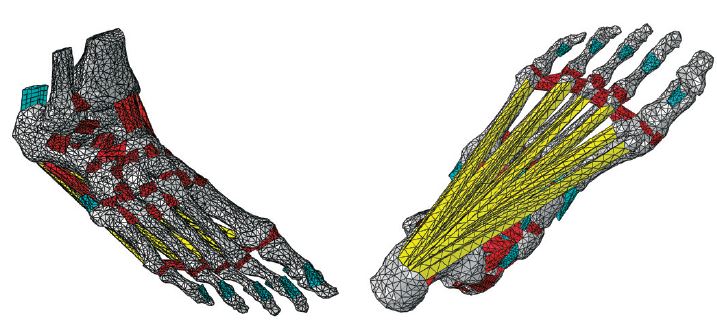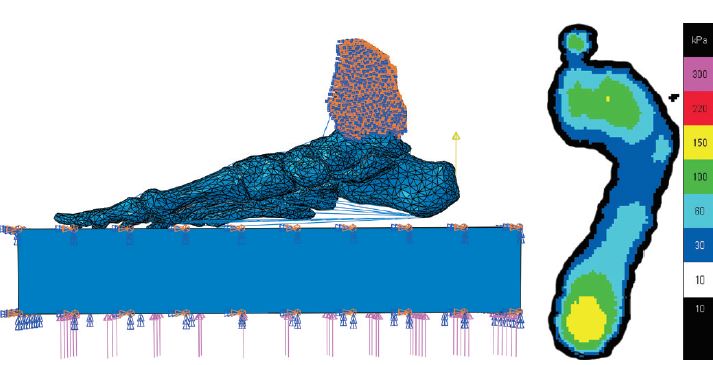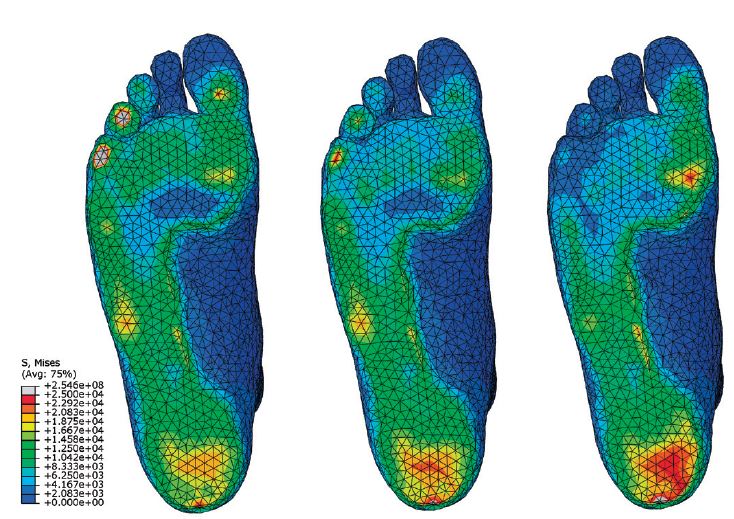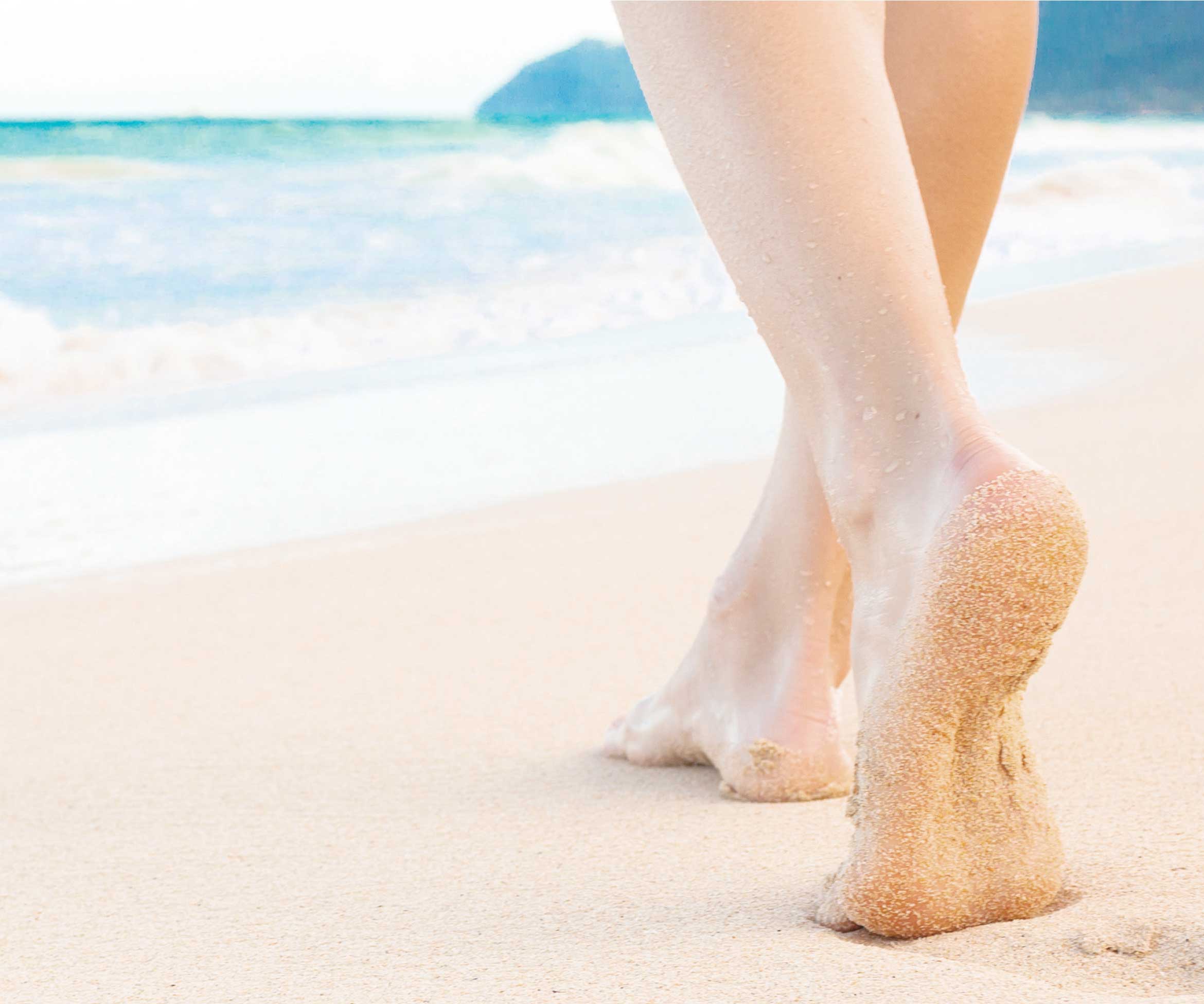RITSUMEIKAN UNIVERSITY
Ritsumeikan University is taking steps towards a more realistic solution as a medical device.
University researcher Dr. Wang Zhongkui has only been using SIMULIA’s software for a little more than a year. However, as a Ph.D. candidate from China who came to Japan’s Ritsumeikan University to study robotics, he had been working with other forms of FEA for a long time—very long, in his opinion. “I used to make my models by myself using my own code, but that would take weeks to prepare the mesh, make the program, and finally finish a simulation. Plus, the post-processing and visualization were not very graphical or pretty,” Dr. Wang says. “When I started working on the challenge of surgical planning for flatfoot, I did some background research and discovered that most people who were modeling biology cases were using Abaqus,” he says. “Human tissue modeling is one of the toughest problems because many of the physical properties are nonlinear. That is, of course, a strength of Abaqus—as well as quality graphics and very nice pre- and post-processing for deformation, stress and so on.” Dr. Wang’s flatfoot project came into being when doctors at nearby Kyoto Prefectural University of Medicine contacted Prof. Hirai Shinichi, who had been Dr. Wang’s supervisor since he came to Japan, asking for help with computer models that could be used for surgical planning to correct severe cases of this common human ailment (see sidebar). Japan is well known for its robotics expertise—and simulations of robots, including detailed models of feet, were a strength at Ritsumeikan. Dr. Wang had finished his Ph.D. by then, and had already started to work on life-science-related simulations for human applications, so the doctors’ request found him willing to take on the challenge. “Deep in my heart, I’ve always wanted to help people,” he says. “By working on medical-related problems with simulation I feel we can make some contribution.”

Dr. Wang had developed his previous FEA models to simulate balanced standing, but contact and friction among neighboring bones were not included, and the gaps among bones were connected by soft tissue, resulting in relatively stiff joints that affected model performance. Once the request came in from Kyoto, he knew he needed to step-up his simulation capabilities. When he switched to Abaqus, Dr. Wang saw remarkable improvements in time as well as quality. “I’m really happy now,” he says. “I don’t need to spend a lot of time preparing the mesh and working out the equations,” he says. “I feel like getting from setup to results is now about ten times faster.” Dr. Wang built his Abaqus model of a single right foot by using geometries of bones and tissue generated from CT images of a 168 cm tall, 62 kg male volunteer (see Figure 1). Ligaments, plantar fascia, and tendons were modeled as either 3D solid parts or tension-only wire parts. Because even with CT images it can be difficult to discriminate these tissues, he referenced the positions of these various components from both anatomy books and instructions from foot surgeons. All of the materials in the foot model were considered isotropic and linearly elastic except for the encapsulated tissue, which was modeled as both linear and nonlinear elastic materials for comparison. The tibia and fibula bones of the lower leg were fixed in space, and a ground plate was loaded and pushed upward with half of the body weight (since each foot carries only that amount) to simulate a balanced standing position. A ground-reaction force and an Achilles-tendon force were also included in the calculations. Dr. Wang ran his simulations with different material properties of tissue and different boundary conditions for the ground plate, then compared the resulting stress maps against experimental measurements where the volunteer stood on a pressure platform system (see Figure 2).

Lessons learned along the way
One thing Dr. Wang found was that modeling ligaments and plantar fascia with wire parts (truss elements) produced almost the same performance as 3D solid parts. “So in future work we’ll model with wire parts because they are easier to construct,” he says. He also learned that the material properties of the tissue, and the boundary conditions of the ground plate, had distinct effects on results, so he subsequently fine-tuned the boundary conditions to get the best model performance. He further determined that nonlinear simulation of encapsulated tissue produced more accurate results than linear. Finally, he realized that the flat plantar surface he had been basing his models on was less than ideal for consistency with experimental results (see Figure 3). “We think a relatively curved surface will improve our predictions so we’ll investigate that in our future work,” he says. Next steps for Dr. Wang include validating his flatfoot model and developing simulations of different types of surgery. His team is also going to create 3D-printed, multi-material prototypes from their FEA models. “Abaqus should be able to help us optimize the STL files we use for the 3D printing,” he says. “My hope is that all our work will help doctors better visualize foot-related issues and develop optimal surgery plans that are tailor-made for individual patients,” he says.

Getting a leg up on the competition
So, with everything going on in his laboratory, why did Zhongkui take the time to enter an SCC academic poster contest? “When I saw the Call for Posters [which SIMULIA sends out to all academic users every year] I decided to participate in the poster session because I wanted more chances to communicate with peer engineers and learn from them,” he says. Although he also gave a formal presentation at the event, he liked the opportunity the poster session provided for discussing the details of his research in a more casual way. “To be honest, I was not very confident at first about describing my work because I was a rookie using Abaqus and felt everybody else was an expert,” he says. “However, after I talked with several other attendees who showed interest in my work I regained my confidence and am glad I participated.” The most recent competition drew 26 posters from diverse countries including Australia, Japan, China, Mexico, Belgium, France, UK, Canada, USA, and Germany. The topics covered a variety of research and teaching endeavors and represented many of the important industries that SIMULIA supports. The posters were prominently displayed at the Berlin SCC and attendees were encouraged to browse and then vote for their favorite poster throughout the duration of the conference. No other criteria were specified. It came down to a tight race between four submissions—and Dr. Wang’s poster was chosen as the favorite. He received an iPad Air and congratulations from the main stage at the event. “I was really honored to win!” he says. “My peer engineers’ interest has encouraged me to dig a little deeper and improve my model further so I can show even better results at the next SCC. I will do my best with the help of Abaqus.”
Getting a leg up on the competition
So, with everything going on in his laboratory, why did Zhongkui take the time to enter an SCC academic poster contest? “When I saw the Call for Posters [which SIMULIA sends out to all academic users every year] I decided to participate in the poster session because I wanted more chances to communicate with peer engineers and learn from them,” he says. Although he also gave a formal presentation at the event, he liked the opportunity the poster session provided for discussing the details of his research in a more casual way.
“To be honest, I was not very confident at first about describing my work because I was a rookie using Abaqus and felt everybody else was an expert,” he says. “However, after I talked with several other attendees who showed interest in my work I regained my confidence and am glad I participated.”
The most recent competition drew 26 posters from diverse countries including Australia, Japan, China, Mexico, Belgium, France, UK, Canada, USA, and Germany. The topics covered a variety of research and teaching endeavors and represented many of the important industries that SIMULIA supports. The posters were prominently displayed at the Berlin SCC and attendees were encouraged to browse and then vote for their favorite poster throughout the duration of the conference. No other criteria were specified.
It came down to a tight race between four submissions—and Dr. Wang’s poster was chosen as the favorite. He received an iPad Air and congratulations from the main stage at the event.
“I was really honored to win!” he says. “My peer engineers’ interest has encouraged me to dig a little deeper and improve my model further so I can show even better results at the next SCC. I will do my best with the help of Abaqus.”
What is flatfoot?
The human foot is a miracle of nature, with its 26 bones, 33 joints and more than 100 muscles, tendons and ligaments. The arch underneath the bottom of the foot is a result of the interweaving of these components in a way that is unique to each person. Everyone starts out with flat feet as a baby; the arches usually develop during childhood in most people. Some adults never outgrow their flat feet, and have no problems. But others experience significant foot pain, or issues with their ankles, knees, legs, hips or backs. Foot arches that once were normal can also “fall” over time through normal aging and the accompanying years of walking, running and jumping. The Mayo Clinic website notes that such wear and tear can particularly weaken the tendon that runs along the inside of the ankle and helps support the arch. If a person’s flatfeet become too painful, a visit to a podiatrist may be in order. Scanning tests (x-ray, ultrasound, MRI or CT) may help identify the source of the problem. Treatment can include orthotic devices that support the arch, stretching exercises, special orthopedic shoes, or physical therapy. While surgery is rarely carried out solely to correct flatfeet, in extreme cases it may be necessary, particularly if a tendon tears or ruptures. The American Academy of Orthopedic Surgeons notes that when orthotics or braces provide no relief, surgery can be a very effective way to help with pain and deformity. A surgical treatment plan is created for each individual patient based on what exactly is causing the problem. Foot surgeons tend to have different opinions regarding the optimal fix for a particular case, however. Even when a decision has been reached about how to fix flatfoot (by cutting, shifting or wedging segments of bones, by repairing tendons and ligaments, or by fusing foot joints—depending on the exact nature of the deformity), identifying the best route to successful surgery remains a challenge. Simulation has improved the situation, as models can be built from scan data to be personalized to individual differences in flatfoot deformities.
